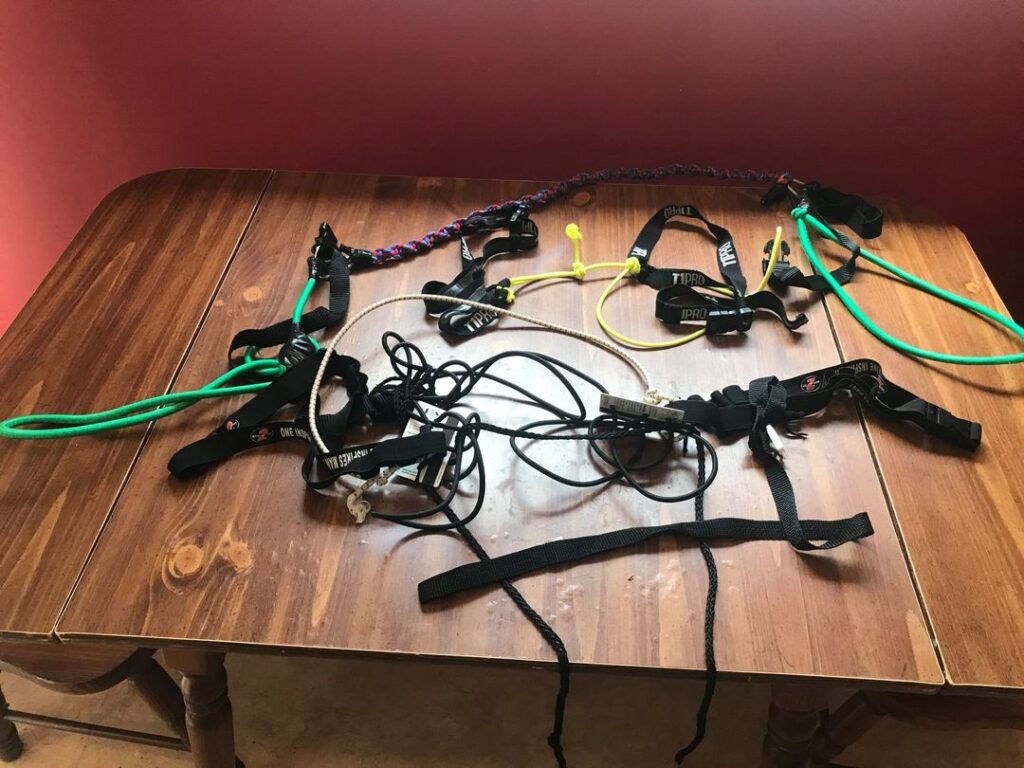
[Photo Description: Paracord Tether at top, SP1belt swim tether below, race belt run tether below, key card swim tether and hand run tether at the bottom.]
Because of my vision, I rely on others’ eyes when I train and compete. For both the swim and run, we’re tethered together. I thought it would be helpful to others to discuss that evolution and what currently works best for me.
During the first few runs, I believe that I did them untethered. I had more sight at that point, and I believed the very visible vests were enough. While they were early on, I knew that the vision would eventually necessitate tethers.
The first iteration of the running tethers were hand carried. While it wasn’t a perfect system, what I found worked best was one of the ‘child leashes’. I found that it was easiest for the guide to hold the handle. And while they worked for a bit, I quickly learned that I needed something else. Simply put, too much focus ended up being put on arm stroke or worrying about losing the tether.
On the swim side, the first tether I used was built by Dare2Tri’s staff. It was a waist tether consisting of a piece of bungee and 2 hotel key cards. Early on, this worked great, and I was able to feel the responsive tug as the guide maneuvered us through the course/around traffic. However, after about a year, they got to a point where the swim tether would continually slip during the race. Because of that concern, I started looking at other swim options.
While the initial swim waist tether wasn’t perfect, it did lead to solutions on the run side. What I found worked best was two of the Triathlon race belts with a piece of bungee connecting them. That has been my run tether since, and it led to the next iteration of the swim tethers.
Prior to Leon’s Triathlon that summer, I overheard someone from SP1belt talking about creating a swim tether using two of their belts. I was intrigued and looked into it more. As a result, before the race started, I had a new swim tether that didn’t slip.
I continued to use that tether for about 2 years. During that time, it became clear that the current tether wasn’t responsive enough. Meaning that I would be too far from my guide before I would feel it go taut and correct. At that point, I was introduced to the Paracord tethers.
These have a two part connection point (waist and thigh), and are connected by a length of paracord. Because of the double connection point, I stopped having stroke interruption on whichever side the guide was on. It worked well during the 2019 season, and I’ll be looking at another version for 2021’s season.
So to review, what I’ll be using for the 2021 season is a run tether that consists of 2 tri belts connected by bungee and a Paracord constructed swim tether. I will be going to smaller paracard so that I’ll have a lighter swim tether.
If you’re interested in being my eyes for training or racing in 2021, please reach out. The projected schedule includes Indoor Triathlons, Sprint Triathlons, an Olympic Triathlon, Sprint Duathalons, Sprint Aquathons, 5Ks, 10Ks, Half Marathons and 70.3s. If you are, I only ask these two things:
The first is that you’re extremely proficient in the discipline(s) that you’re going to guide for me in. Typically, your worst speed should equal 90% of my estimated best.
The other is that you have a good attitude and are willing to learn. Before the first time out, we’ll spend at least 10-15 minutes talking to ensure that we’re both on the same page.